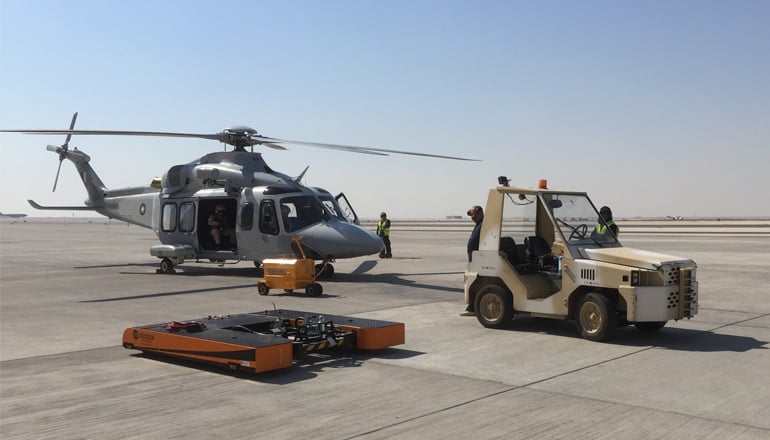The aftermath of the past two years has sent shockwaves across the world markets. They may have begun as ripples, but the ripples have turned into waves as the international supply chains go from one shock to the next with no real time for reset along the way.
We have all felt it at the pump, as fuel prices soar with no end in sight. This comes as we are hearing that there is only about a two percent reserve on global fuel supplies. If aviation gets back up to pre-pandemic levels, there will be no strategic reserves. And fuel is only one part of the overall challenge.
Mototok stands ready to offer you solutions to the global supply chain crisis with our extremely low-maintenance, simple, and utterly reliable remote controlled aircraft tugs.
What Is Going On With The Supply Chain?
What exactly is happening right now? We have heard the hearsay: there are no car parts available, driving the price of parts through the roof, and moreover, driving the price of new cars through the roof. If you can find one, that is. Used car prices are at record highs as well.
Well, this isn’t hearsay. In the UK, automobile production is down eleven percent in April. Assembled autos have been sitting in giant lots, waiting on semiconductor chips to arrive and be installed.
So, there are quite literally tens of thousands of cars lined up in rows, and there is nothing anyone can do. Auto dealerships have been feeling the heat, because they have no inventory to speak of. For months, used car prices were pegging record high after record high, although they are slowly starting to recede. But why did this happen in the first place?
Well, it is a ripple effect. The stones that caused the ripple were widespread shutdowns. Our intricate supply chain is not made for stop-and-go driving; it is meant for a sustained pace on the long haul. In our modern world, anything electronic requires the use of semiconductors for operation.
Taiwan dominates the global semiconductor market, and it isn’t even close, holding some sixty-three percent of the global market. Taiwan was hit hard by lockdowns, and in fact led the world in closing down. To say the very least, this proved problematic for the rest of the world. When they locked down, semiconductors were not being produced. But it isn’t as easy as flipping a switch to turn these production systems back on. But that was only the first, albeit most significant, ripple in the water.
Stuck in Transit
Assuming parts are being produced, which is a big ‘if’ at the moment, the next ripple is the ability to ship the components.
Along with record-pacing supply chain issues is a record-breaking issue of job turnover. The Great Resignation as it has been coined, is a serious issue. Not being able to find staff, and when you find workers willing to work, it takes a lot of time to train employees. In 2020, the average training time spent per employee at large companies was over one hundred hours!
Why mention this? Logistics jobs are complex jobs. They are dangerous jobs. And they are jobs that take a lot of time to train correctly and thoroughly. You cannot earn a commercial driver license and be an experienced, competent commercial driver overnight; it takes years and many thousands of miles to become competent. The same is true for working in the world’s ports. Whether it is unloading shipping containers, crude oil, heavy machinery, airplane components, etc., it takes a lot of time, and experienced hands to safely and efficiently move those items.
It is tough to get an exact figure on how many ships are stuck in transit, but we do know that a significant number have been circumventing the backlogged ports, adding thousands of miles to their trips from Asia to offload on eastern ports in the U.S. We can only imagine the issues are the same across Europe.
Impacts on Aviation
The aviation world has been hit hard in the past two years, but that is really a scratch on the surface of the bigger issues. If anything, it started to expose and peel back layers on a problem that has been brewing for a long time.
Every single sortie relies on hundreds of different things working in concert with each other, systems literally going all the way back to the ports in other countries (spare and replacement parts), and climaxes in fuel shortages.
Air freight is an integral component in the overall global supply chain. While it does not carry the lion’s share of freight compared to ships, trains, and trucks, air freight handles expedient freight in ways that other methods cannot replicate.
But there is a catch: freighters are desperate for aircraft, and airlines (including cargo) are desperate for pilots and technicians.
In pre-pandemic times, Boeing anticipated a demand for nearly one million new pilots over the course of the next twenty years. This problem has been brewing for a long time with us first reporting on it back in 2019. The most recent Boeing Commercial Market Outlook put the numbers still at over six hundred thousand pilots and about the same number of technicians to keep up with the rising demand, and to compensate for the amount of pilots and technicians who are aging out and retiring. How bad is it? Well, instead of grounding jets because of a virus, airlines are now grounding jets because they lack pilots.
Fuel
Fuel problems are the most obvious and prescient source of angst right now. We are all feeling it. It is the most obvious sign of the logistics hurdles because we get a taste of it every time we fill up our own gas tanks. Now multiply your tank size by about 50,000 and you have a feel for the struggles facing air travel. Jet fuel has also risen along similar lines as auto gas, and reserves are running short, all while prices are still skyrocketing.
The Mototok Solution
So, where do we go for solutions to ease this burden? Your MRO or operation is certainly feeling the sting. This might seem like the worst time to upgrade your GSE, but we assure it is not; there is nothing indicating that fuel supply issues are going to rain anytime soon.
It behooves you to start exploring alternative forms of operations because there are really three issues at hand here that we can help you curb.
First, fuel dependence. Second, manpower shortages. Third, parts and maintenance of your GSE.
No Fuel Dependence
According to the pundits at CBS News, the work of the diesel surcharges are still coming down the pike. That’s a shocking revelation considering fuel prices have already shattered all-time highs and continue to climb unabated.
Our all-electric tugs relieve you of fossil-fuel dependence at a time when that is a highest priority. Instead, your tugs will be recharged using clean, renewable energy.
Ultra-Low Maintenance
Revisiting the backlog of vessels, the inability to get cargo on shipping vessels to leave their destinations, and the shortage of pilots, parts for repairs are at a premium. Let’s face it: diesel powered GSE takes a lot of work to keep going. Frequent oil changes. Regular tune-ups. Parts that are now hard to find and expensive to get.
Mototok tugs are sealed units. Once you buy one, it does not need the kind of regular upkeep that a diesel unit requires.
Personel Restrictions
This might be the most significant of all the factors. Your company is probably short pilots and short technicians. Technicians go through many hours of specialized training to become certified, and many more to become proficient. It is a literal waste of resources to task them to aircraft ground movement.
The Mototok tugs are so simple that anyone on the team can quickly learn to use them. Instead of taking up the precious time of a technician, one of the non-technical hangar staff can easily be trained to use our tugs and be competent very quickly, unlike a diesel tug that takes many hours of experience.
Our tugs are easy enough and quick enough to allow pilots to move the aircraft themselves, leaving technicians to more technical tasks, and will only add a few minutes onto the preflight protocol.
Conclusion
There are no great solutions right now. Fuel is becoming scarce and expensive. Parts are hard to come by, some still anchored out at sea waiting to be offloaded, others not even being produced due to closure at the factory or at the ports. While updating and upgrading GSE might sound like a luxury, it isn’t; it might be one of the best hedges against the exploding cost of fuel, scarcity of parts, and scarcity of qualified personnel. If the pundits are correct, these issues are only going to deepen. Mototok is ready to service your operations so you can focus on getting a good workforce together rather than who is qualified and competent to move a jet. Give us a call and we will help you figure out how to save your operation time and money with the right aircraft tug.



Comments